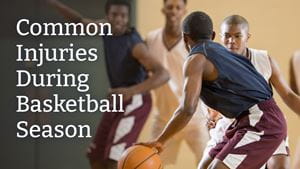
Watching NBA teams compete to earn their spot in the playoffs is a pastime enjoyed by millions of people around the world.
Unfortunately, during some of those games, athletes can suffer injuries ranging from mild to career-ending. These may be something as simple as a mild sprain or as devastating as a full ligament tear.
We asked orthopaedic surgeon and former college basketball player Michael Stanton, MD, for his insight, as he sees athletes for these types of injuries on a consistent basis.
Each individual sport has its own risks of certain types of injuries, based on the muscles and movements that are most common to the sport.
For those who play basketball, one of the most frequent injuries is a muscle strain or sprain. Especially during basketball games, there is a lot of close contact combined with jumping and landing. Coming down onto another person’s foot can lead to someone rolling or twisting their ankle.
Knee injuries, specifically ligament injuries, are also common. A strain or tear of the anterior cruciate ligament (ACL) is the knee injury that is most well-known. ACL injuries are more common in women than in men, according to Dr. Stanton.
“There has been a lot of research on this particular injury,” Dr. Stanton said. “Researchers believe it has to do with the functional mechanics of landing and overall strength training. Some combination of those factors interact with the differences between men and women.”
Athletes will also sometimes tear the meniscus – the cartilage between your shin and thigh bones. This often happens due to sudden twisting motions in the knee.
Another type of serious injury is an Achilles tendon injury. The Achilles tendon is a strong, fibrous cord that connects the calf muscles to the heel bone. If it partially or completely tears while a person is jumping or running, recovery from these injuries can last up to a year – even for professional athletes.
Athletes will spend a lot of time in the offseason and pre-season preparing their bodies and minds for the rigorous pace of regular season play.
Training that athletes undergo helps not only become conditioned to the intensity and physical demands of their sport, but it also serves to strengthen their muscles, tendons, and ligaments. Sport-specific training helps to prevent injuries.
A focus on combining strength training with flexibility and functional training is a key strategy used by athletic trainers and physical therapists. Using these techniques can help to avoid certain positions that put higher stress on the ligaments and tendons used most frequently by athletes.
Building strength in your body is helpful, as it gives you more power. However, athletes need to ensure that strength can integrate with the mechanics of whatever sport they are playing.
Proper stretching is important, as all the muscle groups need to be warmed up before being put through periods of intense exercise. This can be combined with functional workouts that help athletes train specifically for the movements they will be doing repetitively in their sport.
“There has always been a focus on strength training – being in the weight room and getting stronger,” Dr. Stanton said. “I think we are learning more and more that the flexibility and functional training plays such a big role along with strength training.”